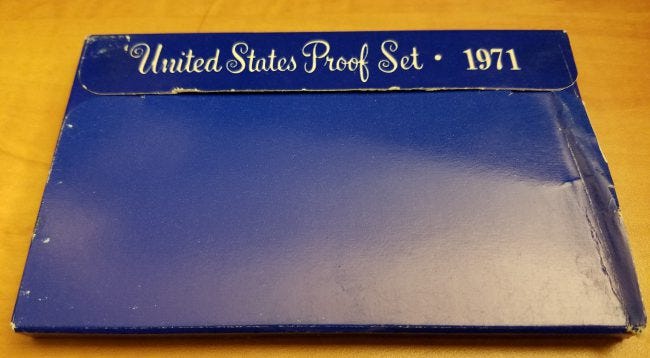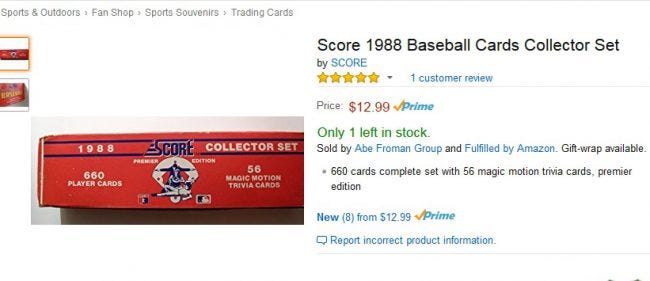Nothing Collectible Is Collectible

It seemed like a tall order, and possibly an expensive one. There's been a bit of coin collecting going on in the house lately, so for Christmas I had the idea of getting the US Mint Proof Sets from the years than Danger Girl and I were born. Since I'm older, I anticipated that my proof set would be harder to find, and more expensive when I did find it. I was wrong on both counts. eBay is absolutely engorged with US Mint proof sets from the past sixty or so years.
In the end, I paid about five bucks for my set and about six bucks for DGs. Had I been patient, I could have bought a package of 250+ proof sets, including all of the Sixties, Seventies, and Eighties, for about a hundred dollars. Making the individual value of a US Mint proof set somewhat less than the face value of the coins in the sets. You could make a couple bucks an hour buying proof sets in bulk and taking the painstakingly finished, utterly pristine, four-decade-old coins to the local bank.
A new 2016 Proof Set from the US Mint costs $31.95. It contains $5.91 in proof-minted currency. I own a set, because I like pretty coins, but I'll explain to you why it probably won't even be worth $5.91 in twenty years. Hint: it's the same reason the $150 BMX bike stolen out of my garage in 1994 is now worth $2,500.
The notion that old things are worth more than new things is, in itself, not very old. Prior to the nineteenth century, most people didn't give a damn about Roman coins or original folios of Shakespeare. It's true that there have always been people who studied old objects in order to learn more about history, but the idea that an old object might have intrinsic worth just for having survived didn't really gain any traction until well into the Industrial Revolution.
Prior to the aforementioned Industrial Revolution, we looked at objects differently. Everything from a sword to a plowshare had intrinsic value based on how much human capital it would take to duplicate. Very few things were thrown away or wasted. And nobody got excited about old stuff because they were surrounded by old stuff all the time. This was doubly true in Europe where people grew up in the shadow of the Colosseum and the cathedrals, which were about as exciting to them as Dublin High School (constructed 1970) was to me as a teenager.
The arrival of mass production broke the iron band between human capital and manufactured goods. A relative abundance of everything from sewing needles to firearms changed the way we viewed everything. For about a hundred years, newness was prized above all else. Some time after World War II, we began to see signs of what I think of as facilitated nostalgia.
Human beings are nostalgic by nature, more so as we age. But a caveman had no way of indulging this with possessions. Either he was using the same axe that he used as a child, or he'd lost the axe and had been forced to get another one. There was no merchant out there selling Retro Reissue 3000 B.C. Axes to cavemen. It took widely-accessible markets to make that sort of thing happen, and it took an excess of purchasing power to fund it.
The Boomers were the engine behind a Golden Era Of Antiques, denizens of an economic and spiritual paradise who nevertheless couldn't stop looking backwards at their perfected childhoods. ("If you want to be really authentic about nostalgia for the Seventies," one wag wrote a while ago, "you have to get your head around the idea that much of the Seventies consists of nostalgia for the Fifties.") It would be easy to laugh at them and the way they inflated the prices of everything from a 1959 Les Paul to a 1970 Chevelle to the stratosphere --- but didn't I, the enlightened Gen-Xer who believes in nothing, just pay serious money for two reproductions of BMX bicycles from 1986? Yes I did. So the ground beneath my feet on this issue is more like shifting sand.
Which, speaking of BMX bicycles, brings me to two ways you could have spent $175 about thirty years ago. While recovering from a crippling neck-snapper of a crash back in 1988, I started collecting baseball cards. It was the right time to be excited about baseball cards; outrageous prices were being paid for Mickey Mantle rookie cards, Mark McGwire Olympic cards, and Ken Griffey Jr. cards of all types. You could get serious money for print errors like the "Fuck Face" Billy Ripken card, too. Everything was worth money. New collectors were pouring into the hobby, inflating the price of everything and anything.
The insane amount of enthusiasm being devoted to baseball cards led to the creation of two new baseball-card companies: Upper Deck and Score. The 1988 Score set was oversubscribed from the moment it was announced. It wasn't uncommon to see sealed full sets going for $40 or $50 against a retail price of $21.95. Some time in 1989 I attended a card show in downtown Columbus and I watched an extraordinarily fat man wobbling out of the building clutching a stack of Score sets that went above his head. It was quite a balancing act. But let's move to the present day. How much have those Score sets appreciated? Are they worth the $10,000 that a complete 1958 Topps set would have fetched in 1988? More? A lot more?

Oh. That's not an unusual price. eBay is full of no-sale Score sets at $21.95, $19.95, $15.95. The actual value of a Score set is probably nothing. Bad news for me, because I have one. I bought it at a screaming-deal $22 thirty years ago. The smartest thing to do with it is probably to throw it in the trash.
About eighteen months after I bought that Score set, I spent $175 on a complete JMC Darrell Young BMX bike in chrome. I did this because my BMX hero, Richie, had ridden one back in 1984. Later on the year, I bought a complete JMC Andy Patterson for $150. Both of these deals came out of the Columbus Dispatch classifieds, by the way.
The Darrell Young was stolen out of my garage in Hilliard, OH by two kids who saw the door up and decided to grab a pair of bikes. I came out of the garage when they were riding away. I had to choose which one of them to run after. One kid had the Darrell Young. The other kid had my actual race bike that I was racing, a Badd&Company Stretch Pro. I went after the bike I really needed; the kid decided to dump it and run rather than try to ride it across a grass field. I had a Glock 21 in my waistband at the time and remember thinking I should have shot both of the kids dead. "But what's an old JMC worth?" I asked at dinner later that evening, rhetorically.
The answer to that question today? Well, a white frame/fork/bars is worth $2,800. A chrome complete bike? More than that, I promise you. The Andy Patterson I had? Also three grand or more. The story of how I lost that bike is one I'll tell another time: it involves hillbilly three-ways, liquor-store robberies, shooting a Chinese rifle at sheriff's deputies, and denim clothing. A LOT of denim clothing.
No prize for guessing that I wish I'd left my baseball cards in the garage and my bikes in my basement, instead of the other way 'round. But why is a sealed 1988 Score set worthless when a 1984 BMX bike is worth as much as a year-old Kawasaki Ninja 300? And what does that have to do with coin sets?
The answer is simple. Items that are designed to be collectible from the moment they are made tend to be stored away in perfect condition. And that's how they remain. People forget about them. They lose emotional value. They aren't associated with any exciting memories or personal experiences. After a while, they're just junk.
By contrast, BMX bikes get broken, bent, rusted, thrown away. I bet you that both of my old JMCs are sitting in a dump somewhere. That happens to toys as well --- but any collector of Star Wars toys will tell you that worn-out, fondled-and-played-to-death figurines from 1977 are still easy to find. It's the boxes that are worth money, because the boxes got thrown out.
If you could plot the number of currently-extant mint-condition 1988 baseball-card sets and the number of currently-extant good-condition 1984-model-year BMX bikes over time, you would see the former on a more or less steady line while the latter falls off dramatically for the first decade before leveling out way below the original figure. At the same time, more and more people are getting interested in owning something from their BMX past even as they express total apathy about old sealed baseball-card sets. It's a supply/demand curve that is very much in the bicycle's favor.
US Mint proof sets are just like baseball-card sets. You have to assume that virtually all of them are still around in like-new condition. And you also have to assume that nobody really gets excited about them. In the end, they're worth less than face value because the time you'll take to get the coins out of their holders also has some value and that has to be factored in.
All of the truly valuable coins, just like all of the truly valuable baseball cards, were originally distributed as non-collectible items. I guarantee you that there were kids riding down Main Street USA with Mickey Mantle rookie cards in their bicycle spokes, even as they used 90% silver quarters to buy hamburgers at the local diner. By the time those kids were grownups who wanted to connect with their past, the quarters were worth $5 each or more and the cards were worth thousands.
My son has started collecting precious metals. I've strongly advised him to stay away from coins and to focus on reputable bullion; so far he's buying heavily (for a seven-year-old) in Valcambi grams of gold, platinum, and palladium. There's a lot of discussion in precious-metal circles about the value of certain coins or bars or rounds. Trust me; it's all stupid, all ridiculous, all pure ignorance. There are a few coins that might have a slight value premium fifty years from now because they are easier to authenticate, but in general nothing you buy from APMEX or the other vendors will be worth a penny over melt value in thirty years.
What will be valuable and collectible? My crystal ball is broken, so I couldn't say. Maybe nothing. Most young people spend most of their time interacting with computers and tablets nowadays. Vintage computers have only sentimental value, so I'm guessing that "vintage iPads" won't be worth much in the year 2046. (If you think otherwise, I own six Atari 800s and I'm open to offers.) The ideal collectible would be:
Popular when it was released
Not over-produced
Relatively ephemeral/fragile
And some other mystery factor to be discovered when it's too late.
If you figure out what that might be, let me know. In the meantime, I will try to figure out what to do with my old baseball cards. I'm thinking that I might use my Score set as a substitute for a "Duraflame" log. Or, better yet, convince everybody else to do that, while I keep my set in pristine condition. IF you want a Dave Henderson '88 Score after the great Duraflame Baseball Card Burning of 2017, where you gonna go? Right here, my friend. I'll leave the garage door open for you.

